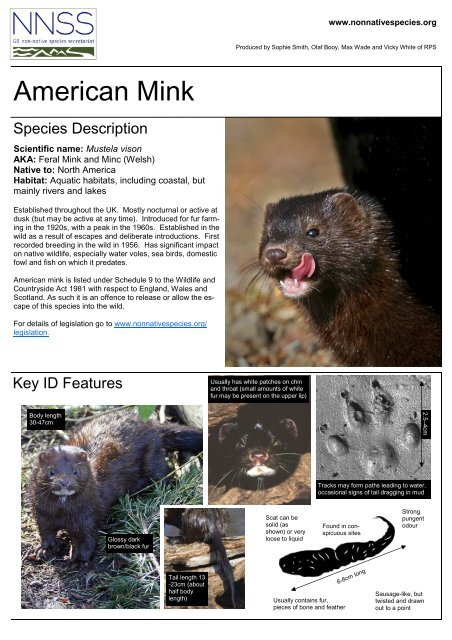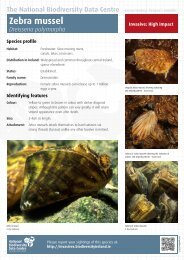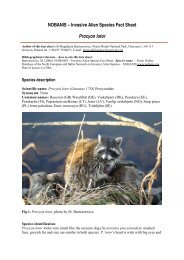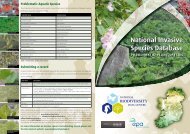American Mink (Mustela vison)
American Mink (Mustela vison)
American Mink (Mustela vison)
Create successful ePaper yourself
Turn your PDF publications into a flip-book with our unique Google optimized e-Paper software.
<strong>American</strong> <strong>Mink</strong><br />
Species Description<br />
Scientific name: <strong>Mustela</strong> <strong>vison</strong><br />
AKA: Feral <strong>Mink</strong> and Minc (Welsh)<br />
Native to: North America<br />
Habitat: Aquatic habitats, including coastal, but<br />
mainly rivers and lakes<br />
Established throughout the UK. Mostly nocturnal or active at<br />
dusk (but may be active at any time). Introduced for fur farming<br />
in the 1920s, with a peak in the 1960s. Established in the<br />
wild as a result of escapes and deliberate introductions. First<br />
recorded breeding in the wild in 1956. Has significant impact<br />
on native wildlife, especially water voles, sea birds, domestic<br />
fowl and fish on which it predates.<br />
<strong>American</strong> mink is listed under Schedule 9 to the Wildlife and<br />
Countryside Act 1981 with respect to England, Wales and<br />
Scotland. As such it is an offence to release or allow the escape<br />
of this species into the wild.<br />
For details of legislation go to www.nonnativespecies.org/<br />
legislation.<br />
Key ID Features<br />
Body length<br />
30-47cm<br />
Glossy dark<br />
brown/black fur<br />
Tail length 13<br />
-23cm (about<br />
half body<br />
length)<br />
www.nonnativespecies.org<br />
Produced by Sophie Smith, Olaf Booy, Max Wade and Vicky White of RPS<br />
Usually has white patches on chin<br />
and throat (small amounts of white<br />
fur may be present on the upper lip)<br />
Scat can be<br />
solid (as<br />
shown) or very<br />
loose to liquid<br />
Tracks may form paths leading to water,<br />
occasional signs of tail dragging in mud<br />
Found in conspicuous<br />
sites<br />
Usually contains fur,<br />
pieces of bone and feather<br />
6-8cm long<br />
Strong<br />
pungent<br />
odour<br />
Sausage-like, but<br />
twisted and drawn<br />
out to a point<br />
2.5–4cm
Similar Species<br />
<strong>Mink</strong> are very similar to polecats but can be distinguished by the white<br />
markings on their face. While ferrets are also similar size and shape,<br />
they are usually very different in colour. Note that polecats and ferrets<br />
may interbreed producing offspring with intermediate characteristics. The<br />
only other species that may be confused with mink is otter, however this<br />
is easily distinguished by its considerably larger size as well as through<br />
field signs such as tracks.<br />
<strong>Mink</strong><br />
For comparison<br />
Polecat<br />
Native<br />
(<strong>Mustela</strong> putorius)<br />
White above upper<br />
lip creates a mask<br />
Otter<br />
Native<br />
(Lutra lutra)<br />
Much larger- twice the length and<br />
7-10 times the weight (1-1.2m long<br />
from head to tail, 7.5-10.3kg weight)<br />
<strong>Mink</strong> generally do<br />
not have white<br />
above the lower lip<br />
White tips to ears<br />
<strong>Mink</strong> are elusive and field<br />
signs are therefore useful<br />
to aid identification,<br />
however these will not<br />
allow you to distinguish<br />
between mink and<br />
polecat<br />
Tracks<br />
Redrawn from Sargent and<br />
Morris (2003)<br />
Pale upper and<br />
lower lips, pale<br />
cheek patches<br />
Chestnut brown fur<br />
with paler underside<br />
Distribution<br />
Widespread throughout Britain, limited<br />
mainly to aquatic habitats, population<br />
stable<br />
Source: NBN Gateway. Check website<br />
for current distribution<br />
Polecat <strong>Mink</strong> Otter<br />
Note that mink and polecat prints are identical<br />
Approx 1m<br />
Size and Shape<br />
Otter<br />
Polecat<br />
Photos from: Johnny Birks, Olaf Booy, Rick Leche, Mary Frances Loggans, Martyn Nicholls, Les Willis<br />
1cm<br />
<strong>Mink</strong><br />
References and further reading:<br />
Bang, P and Dahlstrom, P (2006) “Animal Tracks and<br />
Signs. OUP Pocket Guide Series”. Oxford University<br />
Press<br />
MacDonald, D (2005) “Collins Field Guide to the<br />
Mammals of Britain and Europe”. Harper Collins<br />
Sargent, G, and Morris, P, (2003). “How to find and<br />
identify mammals”. The Mammal Society<br />
Sterry, P (2005) “Collins Complete British Animals”.<br />
Harper Collins





